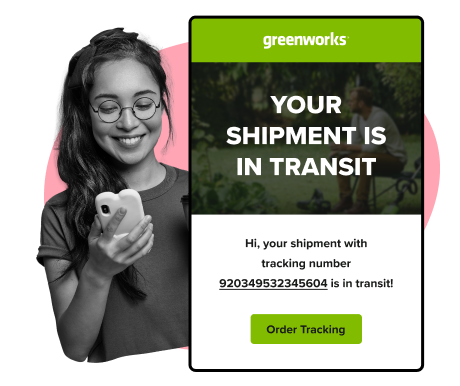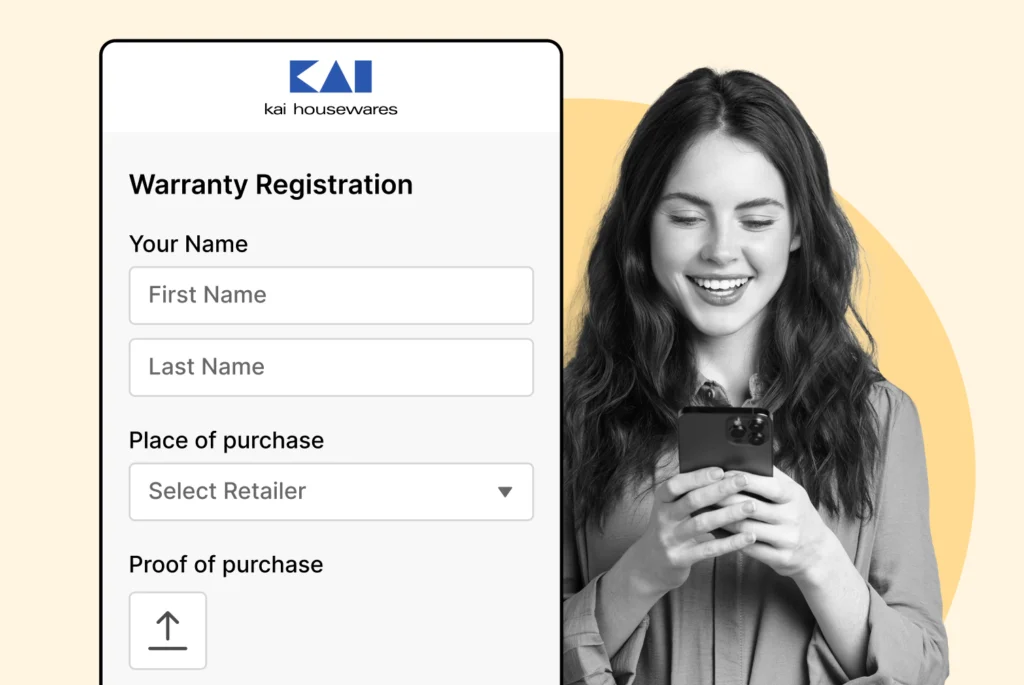
The Mystery of Jilted Jewelry: Return Analytics Unveiled
Explore key analytics on jewelry returns & learn how to reclaim your rings effectively. Discover valuable insights to navigate this process!
Shipping, Tracking & Notifications
Boost customer experience and reduce support tickets
Realtime order and shipment tracking
Proactive order and shipping notifications
AI-Enhanced Discounted Labels
Predictive pre-purchase estimated delivery dates
Self-Serivce branded order tracking
Effortless experience delivered
Identify and Resolve Order Issues
Realtime order and shipment tracking
Make returns profitable and delight customers
Flexibility to define any return destinations & conditions
Simplify returns for your customers and team
Incentivize exchanges over returns
Returns management made easy for your team
Returns management made easy for your team
Easy claims and smart upsells
Understand why your customers are returning
In-Store & Curbside Pickup
Unify the online and the in-store experience
Hassle-free pickup experience for customers
In-Store dashboard to keep operations streamlined
In-Store and Online orders unified
Drive foot-traffic to your stores
Shipping, Tracking & Notifications
Boost customer experience and reduce support tickets
Realtime order and shipment tracking
Proactive order and shipping notifications
AI-Enhanced Discounted Labels
Predictive pre-purchase estimated delivery dates
Self-Serivce branded order tracking
Effortless experience delivered
Identify and Resolve Order Issues
Realtime order and shipment tracking
Make returns profitable and delight customers
Flexibility to define any return destinations & conditions
Simplify returns for your customers and team
Incentivize exchanges over returns
Returns management made easy for your team
Returns management made easy for your team
Understand why your customers are returning
In-Store & Curbside Pickup
Unify the online and the in-store experience
Hassle-free pickup experience for customers
In-Store Dashboard to keep operations streamlined
In-Store and Online orders unified
Drive foot-traffic to your stores
Boost customer experience and reduce support tickets
Realtime order and shipment tracking
Proactive order and shipping notifications
AI-Enhanced Discounted Labels
Predictive pre-purchase estimated delivery dates
Self-Serivce branded order tracking
Effortless experience delivered
Make returns profitable and delight customers
Flexibility to define any return destinations & conditions
Simplify returns for your customers and team
Incentivize exchanges over returns
Returns management made easy for your team
Equip your team for precise return checks.
Easy claims and smart upsells
Understand why your customers are returning
Unify the online and the in-store experience
Hassle-free pickup experience for customers
In-Store Dashboard to keep operations streamlined
In-Store and Online orders unified
Drive foot-traffic to your stores
Find the answer to all your questions
Take a step by step trip through our functionality to see how we can improve your ecommerce processes.
Explore the most comon questions about WeSupply
Calculate the ROI that WeSupply can bring you
Read actionable articles on how to optimize your post-purchase experience and decrease support tickets
Get inspired by stories of how our customers implemented an effortless post-purchase experience
Wondering if WeSupply is a good fit for you? Read through our use cases to see how we can help you increase conversion & improve CX!
A Deep Dive into Top Companies' Order Tracking & Returns Strategy
Find the answer to all your questions
Explore the most comon questions about WeSupply
Calculate the ROI that WeSupply can bring you
Request a no strings attached review of your current shopping experience and missed conversion opportunities
Take a step by step trip through our functionality to see how we can improve your ecommerce processes.
Read actionable articles on how to optimize your post-purchase experience and decrease support tickets
Get inspired by stories of how our customers implemented an effortless post-purchase experience
A Deep Dive into Top Companies' Order Tracking & Returns Strategy
Wondering if WeSupply is a good fit for you? Read through our use cases to see how we can help you increase conversion & improve CX!

In today’s competitive e-commerce landscape, managing shipping costs effectively is critical for maintaining profitability and customer satisfaction. Managing eCommerce shipping costs is crucial for profitability, as rising freight charges, especially after the global shipping rate fluctuations seen in recent years, can take a significant toll on businesses. If not managed well, shipping costs can eat into your margins, and worse, lead to customer dissatisfaction if prices are too high. Fulfillment services play a vital role in optimizing shipping costs and enhancing operational efficiency. To remain competitive and profitable, businesses must enhance their shipping policies. The goal is to reduce shipping expenses without compromising service. This article explores seven tips to help businesses optimize their shipping processes and cut costs efficiently.
Optimizing packaging is one of the most effective ways to reduce shipping costs. Using the right-sized package for each item ensures that you’re not paying for unnecessary space. Over-sized packages can trigger dimensional weight charges, which inflate the shipping cost based on volume rather than weight. By choosing smaller, more compact packaging, businesses can significantly reduce costs. For example, a fashion retailer can switch from using large cardboard boxes to bubble mailers or polybags for lightweight products, reducing packaging costs without compromising product protection.
Additionally, reducing package weight is another key consideration. Heavier packages lead to more shipping costs, impacting both the seller and the customer. Lighter materials or reducing filler materials can help lower costs. For instance, replacing heavy cardboard with lighter bubble mailers for jewelry or accessories can make a significant difference. Also, when calculating shipping costs, consider dimensional weight, a method used by many carriers to determine how much space the package occupies. Using efficient packaging that minimizes unused space ensures that your shipping fees are based on actual weight and not inflated by excess dimensions.
Switching to eco-friendly packaging materials is a smart way to reduce shipping costs while promoting sustainability. These materials are often lighter and more compact, which can lead to lower shipping costs. Additionally, eco-friendly packaging is typically biodegradable and recyclable, helping to reduce waste and minimize environmental impact.
Some examples of eco-friendly packaging materials include:
Biodegradable Packaging Peanuts: These are made from natural, non-toxic sources and dissolve in water, making them an excellent alternative to traditional Styrofoam peanuts.
Recycled Paper Packaging Materials: Using recycled paper for packaging can significantly reduce costs and environmental impact.
Compostable Packaging Bags: These bags break down naturally and can be composted, reducing landfill waste.
Reusable Packaging Containers: Investing in durable, reusable containers can save money in the long run and reduce the need for single-use packaging.
By adopting eco-friendly packaging materials, businesses can not only reduce their shipping costs but also appeal to environmentally-conscious customers, enhancing their brand image and customer loyalty.
To lower shipping costs, businesses should streamline their shipping operations. High shipping costs are a significant barrier to online shopping and often lead to cart abandonment. Reducing these costs is crucial for enhancing customer experience and improving profit margins, especially for small businesses. One way to do this is by consolidating shipments. Rather than sending individual packages for each order, consider combining multiple items going to the same destination into one larger package. This reduces the number of trips needed and maximizes load capacity. Consolidating shipments can lead to significant savings, especially if you are handling multiple orders within the same region or local area.
To further reduce shipping expenses, businesses should leverage carrier and service options. For example, if you use an e-commerce platform like Shopify, you can access pre-negotiated shipping discounts with major carriers like UPS and DHL. Shopify Shipping allows businesses to save up to 88% on shipping costs by taking advantage of bulk-rate discounts.
Fulfillment services can also play a crucial role in reducing shipping costs and improving operational efficiency. These services alleviate the burden of labor and shipping logistics, enabling businesses to focus on brand development while providing insights through fulfillment analytics.
Additionally, partnering with Third-Party Logistics (3PL) providers can streamline shipping operations and reduce overhead. A 3PL handles everything from packaging to shipping, and by leveraging their existing infrastructure and relationships with carriers, they can offer lower rates. For businesses that need to ship internationally, working with a freight forwarder can also be beneficial. Freight forwarders handle taxes, duties, and customs clearance, reducing costs and simplifying logistics. Finally, using third-party insurance for shipping protection ensures that you don’t overpay for coverage from carriers, potentially saving on insurance costs without sacrificing safety.
Zone skipping is a strategic shipping method that can significantly reduce shipping costs for high-volume shippers. This approach involves bundling packages together and shipping them to a central location, where they are then sorted and dispatched to their final destinations. By minimizing the number of individual packages that need to be shipped, businesses can take advantage of lower shipping rates for larger shipments.
Zone skipping works by leveraging the cost savings associated with shipping larger volumes. By consolidating packages, businesses can qualify for bulk shipping rates, which are typically lower than rates for individual packages. This strategy not only reduces shipping costs but also increases efficiency by reducing the number of packages that need to be handled and processed.
To implement zone skipping, businesses can partner with a third-party logistics provider or use specialized shipping software to optimize their shipping routes and rates. This approach can lead to significant cost savings and improved operational efficiency, making it an attractive option for businesses with high shipping volumes.
Negotiating and comparing shipping rates regularly is a key strategy in reducing costs. One of the simplest yet most effective ways to lower shipping fees is by negotiating better rates with your carriers. If your business handles a significant shipping volume, you have leverage. Reach out to your carriers and discuss potential discounts, especially if you’re consistent in placing orders. Carriers are often willing to work with you to secure your business, and a small percentage discount on each shipment can add up over time.
Additionally, it’s important to regularly compare different shipping carriers to find the best deal, with a particular focus on low cost shipping options. Online tools and shipping rate comparison platforms can quickly show you the most affordable shipping options for each order based on factors such as weight, size, and delivery location. Using these tools ensures that you are always choosing the best option, saving you money. Also, negotiating long-term contracts with your logistics provider can lock in lower rates and create cost predictability, further stabilizing your shipping costs.
Understanding and accurately calculating shipping fees, with a focus on maintaining a low shipping cost, is essential for reducing costs and increasing customer satisfaction. Overcharging customers for shipping can lead to cart abandonment and customer frustration. On the other hand, undercharging can eat into your profit margins. To strike the right balance, businesses should accurately calculate shipping fees based on product weight, size, and destination. Tools like shipping calculators can help determine the most accurate shipping fees in real-time, ensuring that customers are charged appropriately without compromising your bottom line.
Another consideration is factoring shipping fees into your product pricing. Many businesses include shipping costs in the price of the product itself, which allows them to offer “free” shipping and absorb the cost in the overall pricing strategy. This approach can increase your Average Order Value (AOV) and improve customer satisfaction. It’s also important to stay updated on shipping rate changes to adjust your pricing strategies accordingly.
Tracking and analyzing your shipping data provides valuable insights into your shipping operations. Implementing a well-planned shipping strategy is crucial for managing shipping costs and protecting profit margins. By reviewing where orders are being shipped to, you can identify trends and make informed decisions about shipping routes and costs. Analyzing this data also helps pinpoint inefficiencies in your processes, such as excessive shipping distances or unnecessary packaging that can be reduced. Regular audits of your shipping operations will highlight opportunities to optimize your approach, saving money in the long term.
Inflation, rising fuel costs, and freight rate fluctuations also affect shipping costs. It’s important to keep track of these variables so you can adapt your shipping policies accordingly. Using analytics tools provided by your logistics provider can help you manage your costs more effectively. These tools track key metrics such as delivery times, route efficiency, and cost per shipment, offering data that can help you adjust and optimize your shipping strategies over time.
Reducing shipping distance is one of the most effective ways to achieve low cost shipping. The further a package has to travel, the more expensive it becomes to ship. By establishing local warehouses and distribution centers, businesses can store products closer to their customers, shortening the distance for each shipment. This not only reduces shipping costs but also improves delivery times, enhancing customer satisfaction.
Offering local or regional delivery services can further reduce shipping distances. This approach is especially beneficial for businesses with a strong local customer base. By using fulfillment centers strategically located near major population centers, businesses can lower their shipping costs and improve delivery speed. Additionally, using a logistics provider with a broad network of warehouses can help streamline your operations and ensure that your products reach customers faster and more affordably.
Crafting a shipping policy that balances customer needs with shipping costs is essential for businesses aiming to offer competitive shipping rates while maintaining profitability. A well-thought-out shipping policy can help reduce shipping costs, enhance customer satisfaction, and boost overall profitability.
Here are some tips for creating an effective shipping policy:
Offer Free Shipping on Orders Above a Certain Amount: This incentivizes customers to make larger purchases, which can offset the cost of offering free shipping.
Use Flat Rate Shipping: Simplifying the shipping process with flat rate shipping can help reduce costs and make pricing more predictable for customers.
Provide Expedited Shipping Options: Offering expedited shipping for customers who need their packages quickly can improve customer satisfaction without significantly impacting overall shipping costs.
Utilize Shipping Zones: Determine shipping rates based on shipping zones to reduce costs. This approach allows businesses to charge more accurately based on the distance the package needs to travel.
Leverage Shipping Software: Using shipping software can help optimize shipping routes and rates, ensuring that businesses are always getting the best possible deal.
By creating a shipping policy that carefully balances customer needs with shipping costs, businesses can reduce their shipping expenses, improve customer satisfaction, and enhance their overall profitability.
Shipping expenses can add up quickly, but with WeSupply, you can take control of your logistics, reduce costs, and enhance the post-purchase experience. By leveraging our powerful tools, businesses can streamline order management and returns while cutting down on unnecessary shipping expenses.
Automated Order Tracking & Proactive Notifications: Reduce customer inquiries by up to 23% with real-time shipment tracking and notifications. Fewer support requests mean lower operational costs.
Flexible Return Policies & Cost-Effective Return Shipping: Pre-paid QR code return labels and support for over 100 carriers ensure the most economical return shipping options, reducing overall return costs.
Returns Analytics: Identify patterns in returns to prevent unnecessary shipments and lower return shipping expenses.
Order Flow & Logistics Analytics: Gain insights into order status, shipping times, and processing inefficiencies. Optimize logistics with data-driven decisions to minimize unnecessary shipments and delays.
With WeSupply, you can optimize your fulfillment strategy, improve efficiency, and ultimately lower your shipping costs—while delivering an outstanding customer experience.
Ready to cut shipping costs and streamline your logistics? Book a demo today!
Simplify Warranties for Your Customers and Support Team
Book a quick call with our experts to see how WeSupply can help you: simplify the warranty claim experience with just a few clicks, reduce customer service calls and manual processing, notify your customer about their warranty, automate warranties and reduce user error
Lowering shipping costs is an ongoing challenge that requires careful planning and strategic shipping policies. In addition to optimizing packaging, streamlining shipping operations, leveraging carrier discounts, negotiating rates, understanding shipping fees, and analyzing data, businesses can further reduce expenses by implementing WeSupply’s innovative solutions.
By enabling in-store and curbside pickup (BOPIS), businesses can eliminate shipping costs entirely for select orders while increasing store traffic and reducing cart abandonment. Automated order tracking and proactive notifications help cut customer support inquiries by up to 23%, lowering operational costs. Flexible return policies with cost-effective return shipping options ensure businesses don’t overspend on returns. Returns analytics provide insights into return patterns, helping to minimize unnecessary shipments. Finally, order flow and logistics analytics allow businesses to optimize shipping strategies with real-time data, improving efficiency and reducing delays.
As shipping costs continue to rise globally, leveraging these strategies and tools will keep your business competitive, improve profitability, and enhance customer satisfaction.
To negotiate better rates, focus on leveraging your shipping volume. Contact your carrier directly, explain your growth, and request discounts. If your shipping volume increases over time, this provides leverage to ask for more favorable terms.
Hybrid shipping involves using a combination of carriers for different segments of the delivery process. For example, using UPS for long-distance shipping and USPS for local delivery. This method helps save on costs by combining the efficiency of major carriers with the affordability of regional ones.
Regularly monitor shipping rate changes, adjust your pricing strategy, and optimize shipping routes and packaging. Using technology to track shipping data can also help you stay ahead of cost increases and adjust accordingly.
WeSupply enables businesses to offer In-Store and Curbside Pickup (BOPIS), allowing customers to buy online and pick up their orders in-store. This completely eliminates shipping costs for these transactions while also increasing foot traffic and reducing cart abandonment.
By automating order tracking and proactive notifications, WeSupply significantly reduces customer inquiries—by up to 23%—which cuts down on the need for additional customer support resources. This streamlines operations and allows businesses to allocate resources more efficiently, ultimately lowering overall costs.
Yes! WeSupply provides pre-paid QR code return labels and supports over 100 carriers, allowing businesses to select the most cost-effective return shipping options. Additionally, our returns analytics help identify patterns in returns, enabling businesses to take proactive steps to minimize unnecessary returns and associated costs.
Yes, WeSupply does have an official Shopify App. You can download and begin to integrate it with your Shopify store.
Yes, WeSupply has an official extension for Magento. The WeSupply x Magento integration allows for automating order tracking experiences, reducing customer inquiries, automating shipping email and SMS notifications, and providing a fully branded order tracking experience
Yes, WeSupply has an official BigCommerce App. You can integrate WeSupply with your BigCommerce store to improve your post-purchase customer experience.

Learn How To Create Successful Post Purchase Email Campaigns
Build an effective post-purchase email flow that helps you increase customer satisfaction and drive revenue growth!
Consumers seek the best deals on:

Explore key analytics on jewelry returns & learn how to reclaim your rings effectively. Discover valuable insights to navigate this process!

Discover 7 eco-friendly Shopify merchants making a difference. Support sustainable choices for a greener future!

Discover how effective chatbot strategies can minimize returns in ecommerce. Learn practical tips to enhance customer satisfaction!

Discover effective third-party warranty registration strategies to boost your revenue. Learn practical tips to enhance your business today!

Discover effective strategies to minimize apparel return rates and boost your e-commerce success. Read the article for practical solutions!

Discover 7 eco-friendly Shopify merchants making a difference. Support sustainable choices for a greener future!

Learn how improved customer education can reduce ecommerce returns. Key tips to enhance your strategy and boost customer satisfaction!

Discover how reverse logistics can safeguard your brand reputation and boost customer loyalty. Learn effective strategies for success.

Avoid costly chargeback mistakes that hurt your bottom line. Learn key strategies for improved profitability. Boost your business!